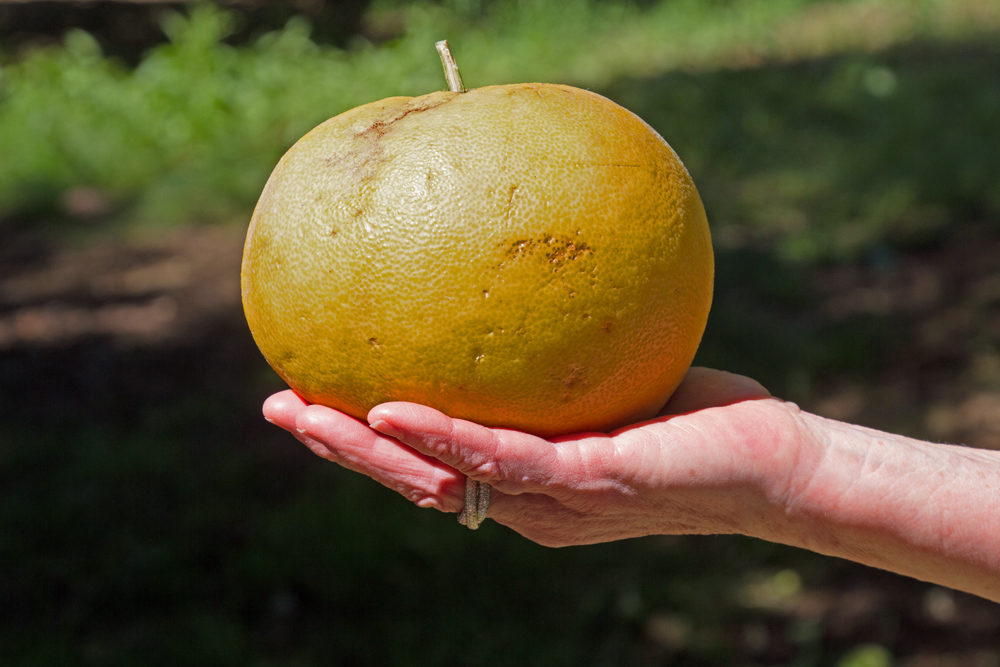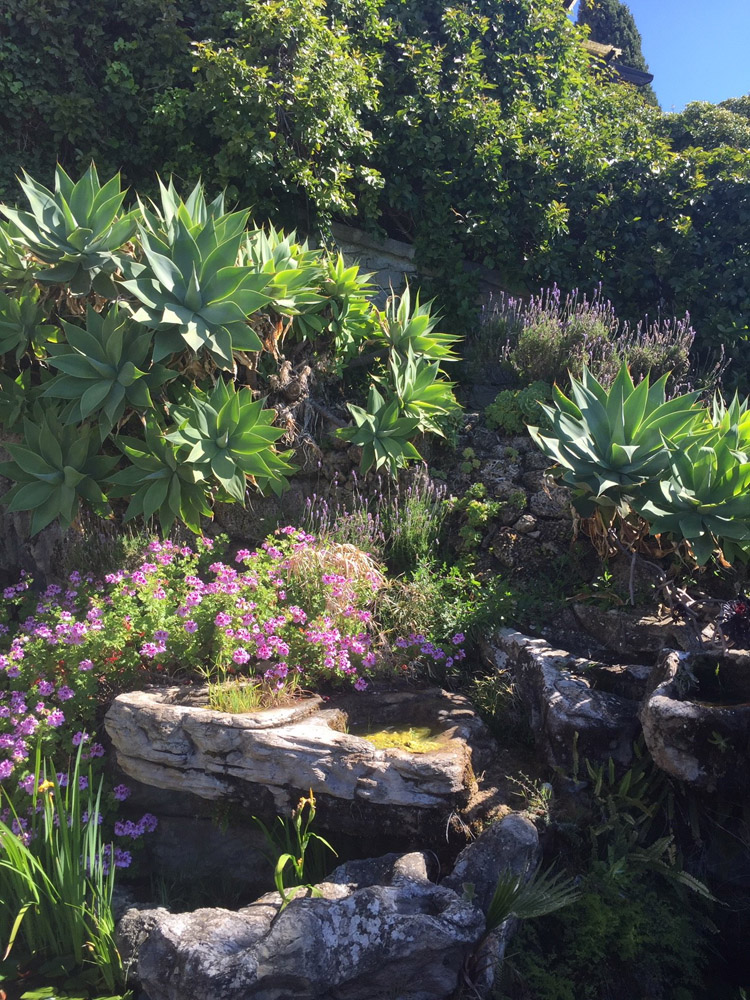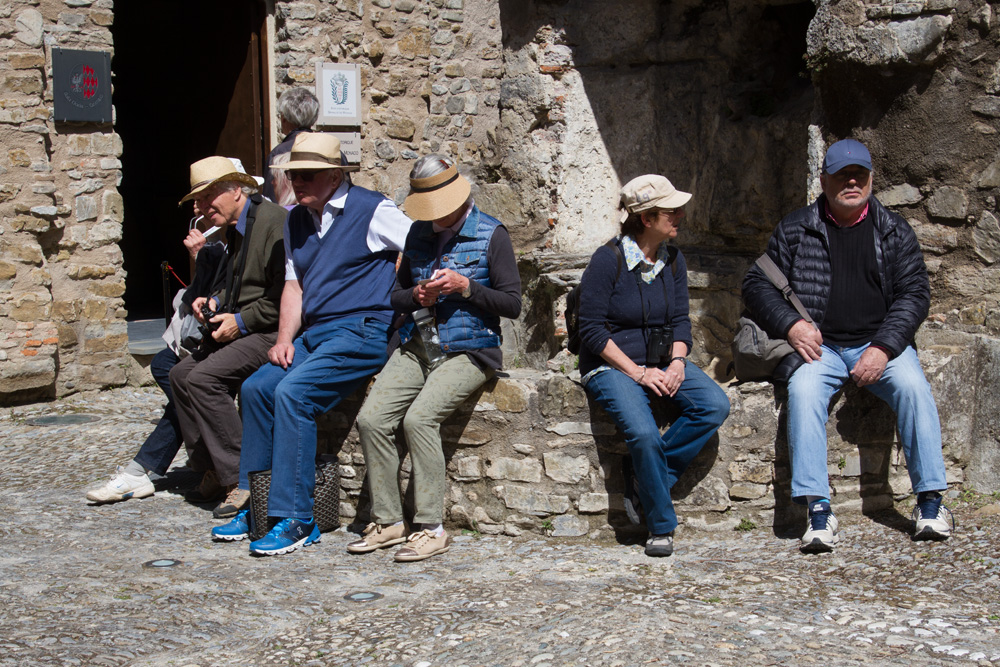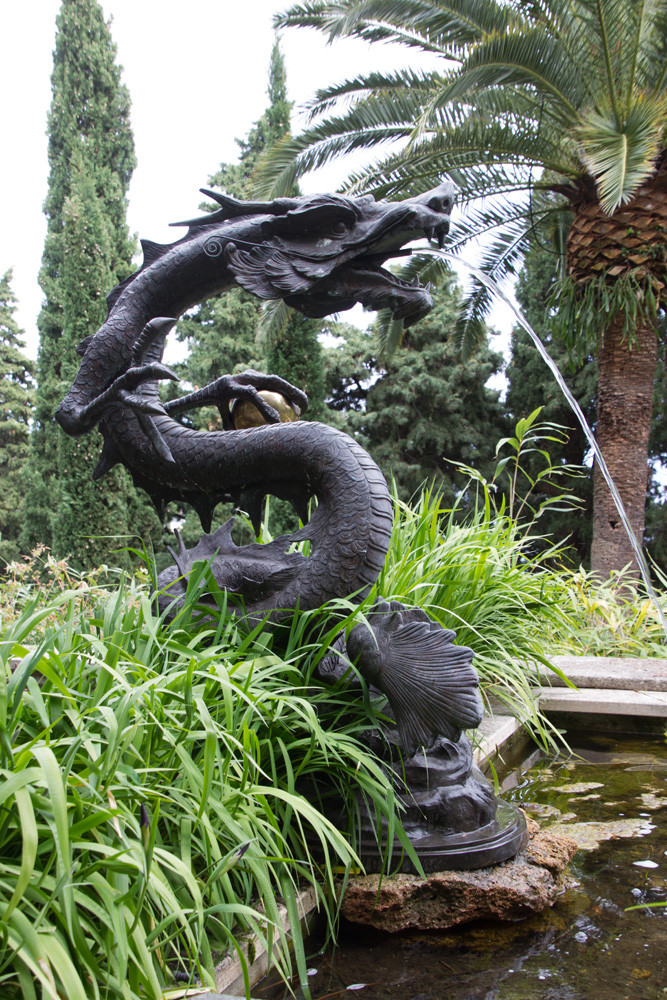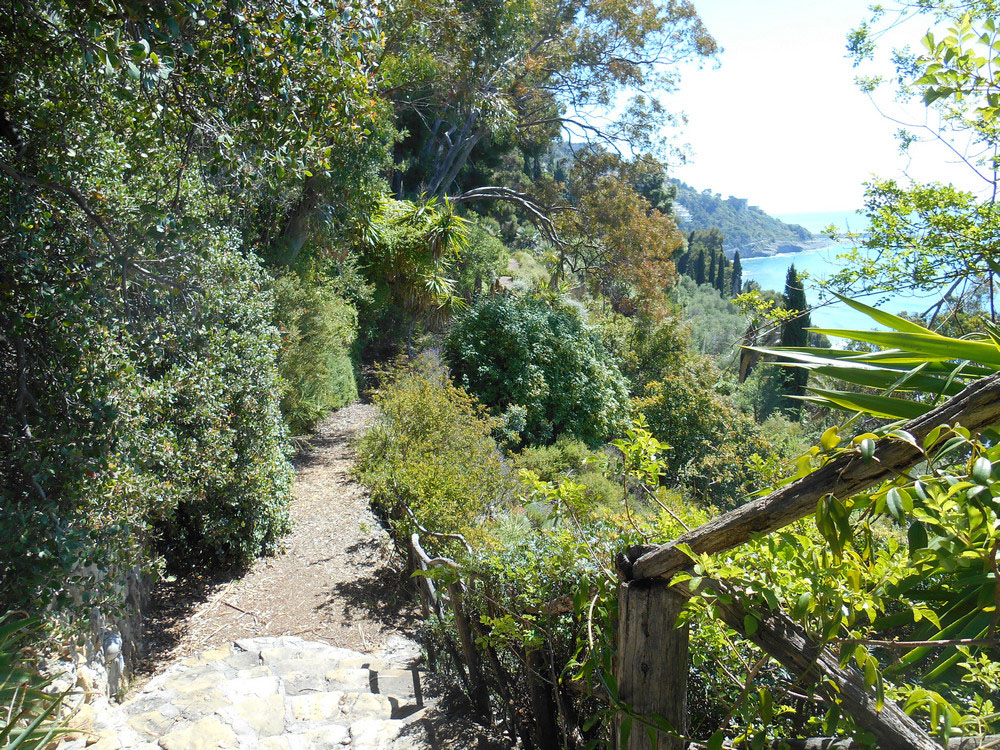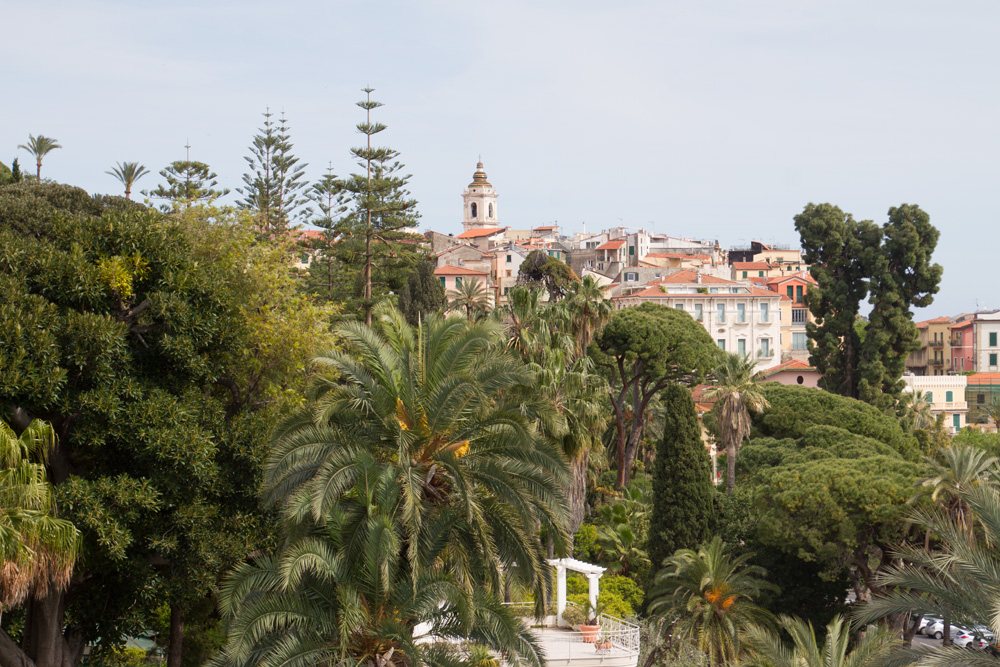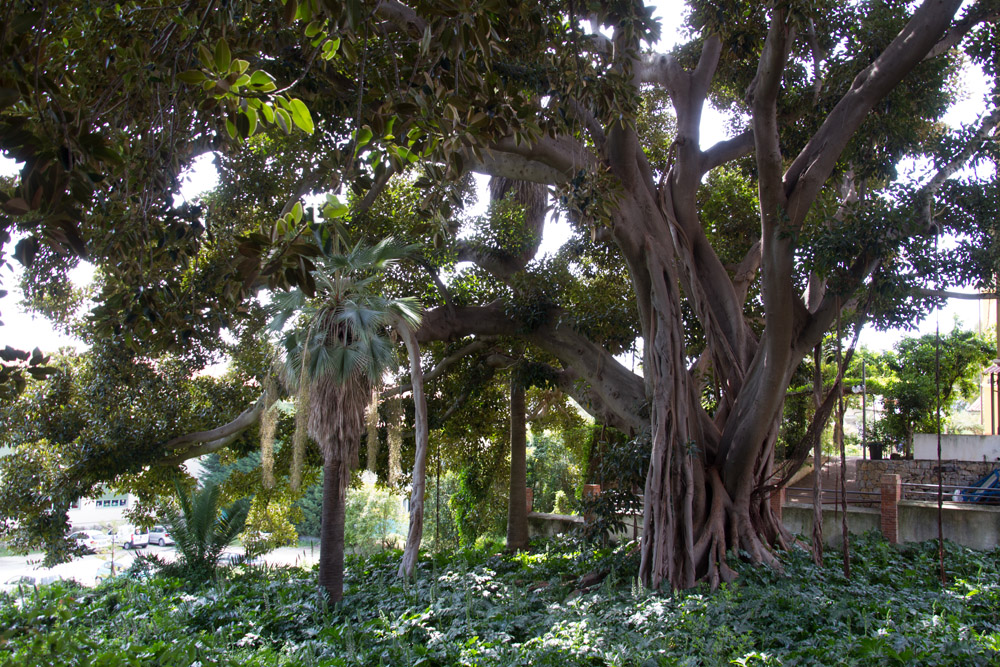May 2019 – Gardens of the Italian Riviera
Click on an image to enlarge it / Cliquez sur une image pour l’agrandir
Le Jardin Botanique Hanbury
Situé sur le Cap de la Mortola, à flanc de colline, le Jardin botanique Hanbury fut créé en 1867 par Sir Thomas Hanbury, un Anglais qui avait fait fortune aux Indes et en Chine dans le commerce des épices, du thé et de la soie.
Le jardin, aujourd’hui sous le contrôle de l’Université de Gênes, est un refuge du monde bruyant des autos et scooters qui passent sur la route au-dessus. La belle villa rose émerge d’une mer de verdure, tandis que la vraie mer en bas reflète le bleu intense du ciel.
Il y a une prolifération dense d’arbres, d’arbustes et de fleurs, mais ce qui frappe le plus, c’est la très grande variété de cactus, qui prennent des formes parfois belles, parfois cauchemardesques. Agaves, aloès et sédums se côtoient, formidablement bien adaptés aux conditions souvent très dures de l’été ligurien.
Les feuilles bleuâtres des Hechtia contrastent avec la masse orange de Sedum nussbaumeriana, tandis que les grands épis bleus des Echium bordent une avenue qui mène à la mer. Ailleurs, une pergola en bois rustique est garnie de wistérias et de rosiers, dont la plus impressionnante variété est Rosa ‘La Follette’. Créée en 1910, ce rosier peut atteindre une hauteur de 20 mètres et produit de grandes fleurs roses parfumées.
En poursuivant son chemin, on arrive à une collection d’agrumes : orangers, citronniers, pamplemoussiers, mandariniers et, plus intriguant, le pamplemoussier pomélo (Citrus maxima), qui produit des fruits gros comme des ballons de foot.
Mais un des lieux les plus enchanteurs est la Fontaine du Dragon, un bassin ombragé bordé de papyrus et orné d’une statue en bronze d’un dragon japonais. Ici on entend le petit bruit de l’eau qui coule tranquillement dans le bassin, ce qui ne semble pas déranger les tortues aquatiques qui font leur sieste sur un tas de pierres.
Ce beau jardin a connu une période de fort déclin après la première guerre mondiale, et doit sa renaissance à la belle-fille de Sir Thomas Hanbury: Dorothy, dite ‘Dodo’, une forte personnalité.
Freya Stark, célèbre exploratrice et écrivaine de livres de voyage, était une voisine des Hanbury pendant les années 30. Dans son autobiographie “Traveller’s Prelude”, Freya raconte comment l’impetueuse Dodo voulait empêcher les villageois d’utiliser l’ancienne voie romaine, la Via Aurelia, qui traverse la propriété, en plantant de petits arbres sur ce chemin public. Freya, de fort caractère elle aussi, se plaisait à les arracher.
Texte: Michèle Bailey
Photos: Michèle Bailey et Ian Davis
The Hanbury Gardens
The Giardini Botanici Hanbury covers 6 hectares of Cap Mortola and descends 100 meters to sea level. It was created by Thomas Hanbury, a passionate botanist, in 1867.
The garden has a micro-climate which enables tropical plants to thrive and plants to bloom much earlier than normal. Local MGF members Maggie and Ivano, who volunteer at the garden, led us on a well-informed tour, pointing out the stars of the season. We were amazed to see lavender in bloom at the beginning of May and particularly liked the wood pergolas which supported Rosa banksiae and wisteria.
Most of the trees are over a hundred years old…
…and there is a rare Xanthorrhoea preissii worth over 7000 euros. The agaves were magnificent, including an Agave franzosinii which will die after it has flowered. There is also a pond of terrapins.
Carolyn Hanbury invited us to her home where we enjoyed a buffet lunch. She then entertained us by describing the varied and prestigious history of the garden.
Text: Jan Morgan and David Ash
Photos: Ian Davis, June Grindley and Jan Morgan
See also: Gardens to visit
Phytotrend Plant Nursery
Maurizio Casale, the owner of Phytotrend, gave us an enthusiastic and knowledgeable tour of his nursery which is dedicated to grasses, most of which, unfortunately, are not frost tolerant. As well as travelling the world searching out new grasses to cultivate and propagate, Maurizio has a good eye for companion plants to enhance the forms of his grasses. He explained that at the time of our visit most of the grasses had been pruned and hence were not displaying their flowers. We particularly liked the Stipa gigantica and Festuca mairei.
Refreshed with fruit juices and much-needed water, we had time to admire the 360 degree views of the sea from the nursery and to purchase coveted grasses.
Text: Jan Morgan and David Ash
Photos: June Grindley and Jan Morgan
Dolceacqua
Jour 2. Une journée sans jardins, parfait pour les non-jardiniers du groupe comme moi. A leur place, une sortie le long de la vallée de la Nervia pour arriver à Dolceacqua, la ville pittoresque et historique où habitent nos guides infatigables et toujours accueillants, Maggie et Ivano.
Une fois rassemblés, nous avons traversé le beau pont médiéval, guidés par un chat de la ville qui a gracieusement accepté une caresse de la main de David Ash comme récompense. Juste à côté, une affiche en fleurs nous a rappelé que Dolceacqua et Bordighera fêtent actuellement la visite à la région de Claude Monet en 1884.
La ville est dominée par son château, qu’on gagne par d’étroites ruelles qui grimpent à travers le vieux quartier. Au début de la montée, Ivano nous a expliqué l’histoire du château. Pendant le Moyen Age, la ville faisait partie des terres fortement disputées par les comtes de Provence et la République génoise. Le château fut construit par un clan puissant génois, les Doria, comme protection contre les incursions de leurs voisins provençaux. En outre, il leur était utile pendant leurs bagarres avec une autre famille génoise, les Grimaldi. Les Doria sont partis depuis longtemps mais les Grimaldi sont toujours à deux pas de Dolceacqua – à Monaco. Selon la plaque murale à côté d’Ivano, ils ont toujours des aspirations sur la ville !
Nous avons monté à un rythme régulier, par des ruelles bordées de studios d’artistes et de magasins offrant des produits locaux pour arriver, enfin, au château. Depuis la plateforme devant l’entrée, il y a un panorama magnifique de la vallée de la Nervia.
A l’intérieur du château, le grand attrait est l’exposition marquant la visite de Monet. Cette visite a produit une quarantaine de tableaux, dont deux sont visibles au château dans une petite salle assombrie. Le sujet du premier de ces tableaux, prêté par le Musée Marmottan-Monet à Paris, est une vue du pont de Dolceacqua. A côté se trouve ‘Monaco, vue de Roquebrune’, prêté par Albert II de Monaco de sa collection privée et rarement exposé. Il est toujours une bonne idée de regarder les tableaux de Monet avec un peu de recul mais avec ce tableau il est indispensable. En n’admettant que quelques spectateurs à la fois, les organisateurs de l’exposition nous ont permis de le faire.
Dehors, des choucas criaient et des hirondelles de rocher tournaient autour du château à la recherche de nourriture pour leurs jeunes. Ces hirondelles nichent dans les falaises qui entourent le château ainsi que sous les avant-toits des maisons du vieux quartier. Pendant notre montée au château, un poussin d’hirondelle tombé de son nid avait atterri dans mon sac à dos. John Graham l’a soigneusement récupéré mais malheureusement le jeune oiseau est décédé, triste rappel que seulement un tiers d’oiseaux sauvages atteignent la fin de leur première année.
Nous sommes descendus par une autre route sinueuse. Sur le chemin, nous avons pu admirer les ruelles transversales, certaines avec leur installation artistique, avant d’arriver devant l’église paroissiale de St. Antoine Abbé.
L’intérieur de l’église nous a offert une profusion de splendeur et d’extravagance baroques. Après une petite pause pour un peu de rafraîchissement spirituel, nous avons poursuivi notre chemin vers I Gumbi pour un rafraîchissement plus corporel. Là nous avons dégusté les vins des propriétaires avant de passer au restaurant (ancien moulin à huile d’olives) pour un repas copieux de spécialités locales.
Après le repas, la plupart d’entre nous est resté à Dolceacqua afin de voir un film en 3-D sur la ville mais Michèle et moi sommes retournés à Bordighera afin de visiter l’autre partie de l’exposition de Monet (dans la Villa Regina Margherita – elle de la pizza éponyme) et d’apprendre davantage sur le fascinant M. Bicknell.
Texte et photos: Ian Davis
Dolceacqua
We gathered at the ancient, picturesque bridge in the medieval town of Dolceacqua, whence one can view the castle on the hill and the scene which Monet painted in 1884.
We then climbed up through the narrow, often covered, winding streets, to the partially ruined castle where Monet’s actual painting is on display – possibly the first time a Monet painting has been exhibited where it was painted. Another painting, on loan from Prince Albert II of Monaco, and which may be Monet’s first really impressionistic painting, was also on show. Both were complemented by an excellent exhibition detailing Monet’s thoughts on the colours and light in the region.
Descending from the castle, we continued our walk through the charming, overarched streets of the old town with its tall medieval buildings, to the Agriturismo restaurant I Gumbi, owned by the charming Eleonora Robotti, for a wine and olive oil tasting. This was followed by an excellent lunch of locally produced ingredients and home-made ravioli.
Text: Elisabeth and Jacques Thompson
Photos: June Grindley and Maggie Vance
Il Visionarium di Dolceacqua
After lunch we headed for the tiny cinema in Dolceacqua, called the Visionarium, which specialises in 3D projections and which has been entirely created by Eugenio Andrighetto. The cinema is full of his meticulous and lovely marquetry work.
We watched his film about the more remote parts of the Nervia valley, made in 1997, showing the landscape of the Ligurian hinterland in all four seasons of the year. The visual effects were clever, and the film was accompanied on surround sound by poems and classical music, providing a romantic portrayal of the Ligurian hinterland, which is rarely visited by tourists, but was painted by Monet. There were also scent effects and noises of running water, a little hammy, but charming.
Another very short 3D film showed a flight of pretty butterflies fluttering convincingly towards us. It was a delightful experience, not to be missed.
Text: Julia Petty
A garden overlooking the Mediterranean
We were very privileged to be able to visit a stunning, new, contemporary house introduced to us by its landscape architect, Simone Ottonello. The property is perched on a hillside overlooking the sea, near Alassio, and all that the eye can see, some 15 hectares, belongs to the owners.
The house was developed from a 300-year-old farmhouse, part of which has been retained and cleverly integrated into the middle section of the new house. Excavating the sloping site was a Herculean task but produced vast quantities of stone which have all been used in carefully crafted walls leaving, wherever possible, massive outcrops which have been integrated into the walls. The entrance to the house is thus enhanced by these huge rocks with substantial cacti perched above them.
Most of the hard landscaping near the house is complete and some planting has begun including a large selection of fruit trees on lower terraces. Outside the ground floor bedrooms there is a clever arrangement of block planting to allow unbroken views to the sea. The main terrace has been left as a wide, very simple space with a few beautifully placed pots in one corner. The future plan is to clear a small amount of land close to the house leaving the rest wild, but with paths cleared through it for access.
Text: Nicola D’Annunzio
Photos: Nicola D’Annunzio and June Grindley
Jardin de la Villa della Pergola
Perché sur les hauteurs d’Alassio, le jardin de la Villa della Pergola est un havre d’ombre et de fraîcheur. Le vert prédomine dans toutes ses nuances, ponctué pourtant par des points de couleur vive. Une variété étonnante de grands arbres, d’arbustes et de cactus s’offre aux yeux du visiteur : la grandeur de l’eucalypte à l’écorce pendante, les formes en vrille des cactus Myrtillocactus geometrizans cristatus et Cereus forbesii ‘Otto’, les feuilles énormes de l’aralie à papier (Tetrapanax papyrifer) et celles du sabal palmetto (Serenoa repens).
En saison le jardin abrite de magnifiques wistérias et une grande collection d’agapanthes mais nous avions raté les premiers et il était trop tôt pour les derniers, hormis quelques fleurs hâtives. Pourtant il y avait de la couleur en abondance. L’orange vif des agrumes choquait parmi toute la verdure. Ailleurs, une potée de pélargoniums bicolores éblouissait les yeux, en contraste avec les fleurs blanches d’une Rosa Banksiae grimpant sur une pergola en fer. Les fleurs roses de Rosa ‘General Schablikine’ cotoyaient celles, très belles, de Rosa ‘Burgundy Ice’, une mutation de la plus familière Rosa ‘Iceberg’.
Au coeur de la verdure se trouvent plusieurs bassins et fontaines. Un dragon japonais veille sur un grand bassin rectangulaire aux allures orientales. Un petit bassin circulaire semble dormir paisiblement sous une couverture de nénuphars et de plantes vertes – même les statues sont noyées dans des fougères. Ce jardin invite doucement au repos et à la méditation.
Texte: Michèle Bailey
Photos: Michèle Bailey et Ian Davis
Villa della Pergola
After an absolutely delicious lunch at Trattoria I Matetti in Alassio, we piled into taxis to get up to the gardens of the hotel Villa della Pergola, once owned by Daniel Hanbury. The gardens were renowned in the 1920s, but following a long period of neglect they were bought by the Ricci family who employed the landscape artist Paolo Pejrone to restore them. Among the plant treasures are 32 varieties of wisteria and 400 of agapanthus, plus a fine specimen of Wollemia nobilis, a living and fossilised member of the Araucariaceae family, discovered in New South Wales in 1994. But for me, the joy of the garden lies in its ‘bones’: the paths, steps, pools and pergolas which twine up the steep hillside, while clever juxtapositions of foliage shapes and colour enhance the structures.
Text and photos: June Grindley
La Villa Boccanegra
Quand on voit le site du jardin de la Villa Boccanegra, on ne peut qu’admirer le courage de sa créatrice, la riche, cultivée et intrépide Miss Ellen Wilmott, une de ces dames anglaises indépendantes et audacieuses qui ne répondent pas à nos idées reçues de l’époque victorienne. Le jardin est niché dans une petite baie et descend vertigineusement vers la mer. Tout à fait en bas, il y a la ligne du chemin de fer. Au loin s’élève la tour de la villa de Sir Thomas Hanbury, voisin et ami de Miss Wilmott.
Autour de la belle maison ancienne, de grands oliviers ombragent des chemins et une cour pavés de cailloux ronds et ornés de potées fleuries. Dans les branches, au niveau du premier étage, les grandes fleurs roses de Rosa ‘La Follette’ grimpe vers le ciel. Les murs de la maison sont tapissés de bougainvillée, de couleur magenta intense.
En s’éloignant de la maison, on plonge dans une profusion luxuriante de végétation, presque une jungle tropicale. Les chemins mènent horizontalement et aussi en diagonal ; des marches en pierre aux balustrades en bois rustique incitent le visiteur à descendre vers la mer.
Tout est entremêlé. Des rosiers et des jasmins grimpent dans les branches des arbres, tandis que des cactus et des aloès semblent se plaire aussi bien dans l’ombre du sous-bois qu’en plein soleil. Le sous-bois est peuplé d’iris bleu, de clivia à fleurs oranges et de germandrées (Teucrium fruticans) aux feuilles argentées. Au soleil les lavandes côtoient les plantes familières de la garrigue.
Du haut des murs en pierres sèches cascadent les fleurs oranges de Mimulus aurianticus et celles roses vif de Lampranthus spectabilis.
Il n’y a qu’une source d’eau dans ce jardin : un ruisseau qui se dessèche en été. Mais dans une clairière, un grand bassin aux allures naturelles apporte de la fraîcheur. Il fait bon de s’asseoir à l’ombre des arbres et de contempler les reflets du soleil sur l’eau et sur les feuilles des nénuphars.
Texte: Michèle Bailey
Photos: Michèle Bailey et Ian Davis
Villa Boccanegra
On the morning of our last day in Liguria we visited the gardens of Villa Boccanegra, thanks to the ‘ferry service’ provided by the owner of the villa Ursula Salghetti Drioli and local organiser Ivano. This was needed because the authorities had just banned parking outside the villa! Ursula, whose family has owned the property for nearly a century, showed us around the large garden originally created by Ellen Willmott between 1905 and 1923. The garden is on a very steep slope dropping down to the sea, giving wonderful views. A rich variety of plants is divided into distinct plantings with many unusual citrus, succulents, specimen trees, shady alleys of rose and wisteria and an extensive collection of pelargoniums. A memorable visit – the merits of the garden endorsed by the RHS via the award of the Veitch Memorial Medal to Ursula this year for her services to horticulture.
Text and photos: Sandy Graham
A garden on top of a mountain
Roberto and Vito made us very welcome to their wonderfully situated garden, perched as it is on the very top of a mountain, with stunning views over the adjacent peaks and the Mediterranean Sea.
I loved their total addiction to plants. Roberto is so interested in how plants adapt and survive in the conditions he has that the aesthetic can get a bit lost, but this didn’t matter to me as he showed us with childlike glee one plant gem after another.
My eye was taken by the views, as well as by the very special plants he has. I was also interested in how he deals with the slopes. The garden makes use of the original terracing and is meant to be viewed from the paths on each level. Steps between the levels are not for the less agile but I enjoyed the sense of adventure so much, I felt like a plant explorer!
The soil depth varies, but there were huge banksias and other tender shrubs and palms seemingly very happy with their exposed positions. The garden also has shady spots. The lower slopes are home to some larger trees and these provide a place for some shade-loving species. Roberto has a plant for every situation and the tall wall on the boundary is home to wonderful echiums, aloes and other exotics, draped like a curtain over the stone.
A garden unlike any other, it left me wanting to be more adventurous with the plant selections for my own sloping site in the sun.
Text and photos: Gordon Cooke
Cactusmania
We were the only couple in the group who chose to visit the Cactusmania nursery in Ventimiglia, and were very pleased to have Ivano with us, as guide and new found friend. We were amazed by what we found there, the scale of the nursery, the quality and variety of the plants in form and size, and the prices varying from two euros to more than a thousand! This was cactus mania indeed. We were so pleased to have chosen this visit, it was something we have never seen before, it was special.
Some of the mature cacti were so large, extravagant and beautiful, it was as if they had arrived from another planet, quite outside our experience. And there were so many of them. Equally the enormous growing-on greenhouses with thousands and thousands of baby plants for a few euros each was an Aladdin’s cave, many already in bloom with the most colourful and elegant flowers.
Cacti are relevant for us in a Mediterranean climate. We already have a selection that thrive, and flower, with just the protection, from rain and frost, of the roof of our open front porch, facing south. They have prospered in the coldest of winter times.
We came away with a large collection of small cacti, ready for potting up and joining their new pals under the porch. It was a strange experience to visit a nursery which didn’t put a price on the label of any plant, except the most expensive! The arrangement is – collect what you fancy and take them to the till, they then price each, and if any is more than you want to pay, you say no thank you and they put them aside and return them to their greenhouse later. We bought 21 plants for 81€! The 1000€ specimens wouldn’t fit in our car!
Text and photos: Graham Petty
Bordighera – Garden City
Legend has it that Bordighera was founded by St. Ampelio at the end of the 4th century AD. Having acquired a reputation for handling red-hot metal (considered miraculous) in his native Egypt, Ampelio fled the resulting publicity, taking with him seeds of the date palm Phoenix dactylifera. He pitched up at Cape Bordighera where he planted his seeds. Today Bordighera boasts the northernmost palm grove in Europe.
This is typical of the area, where flowers seem to spring out of bare rock. Today Bordighera, hugely popular as a winter resort in the 19th century, but afterwards suffering the inevitable decline, is a garden in itself.
As in all Italian seaside towns, Pittosporum tobira is everywhere, perfuming the air with its heavy fragrance. Purple bougainvillea blazes from every wall, sometimes in combination with the sky-coloured flowers of morning glory (Ipomoea purpurea). A mass of greenery enhances and sometimes hides Bordighera’s often eccentric architecture. Olive trees and palms of all sizes compete for space with a variety of conifers, ranging from Norfolk Island Pines (Araucaria heterophylla) with their upside-down leaves to the familiar Mediterranean Umbrella Pines (Pinus pinea).
The villa gardens are packed with colour. The scarlet of Callistemon jostles with the orange of Strelizia while a touch of coolness is provided by the deep blue flowers of Salvia guaranitica and, in deep shade, the white flowers and silver-veined leaves of cyclamen.
A popular but perhaps surprising choice for many gardens is the candelabra tree (Euphorbia ingens syn. E. candelabrum), which grows to astounding sizes in the gentle maritime climate.
The Italian genius for planting up pots is evident in many shapes and forms: a row of eclectically-assorted pots and containers in the old town contrasts with a modern balcony garden, while a traditional balcony complete with washing contrasts with a faintly art deco arrangement with austere but effective planting. Anything goes into pots. Alongside the traditional pelargoniums, petunias and surfinias, you will find lemon and olive trees, rose-bushes, bougainvillea, erigeron, drosanthemum, ferns and a range of cacti and succulents.
The biggest surprise of all lurks down an unobtrusive side-street which leads to the Bicknell Museum, founded in 1886 by Victorian eccentric Clarence Bicknell, friend of Sir Thomas Hanbury. At the time, Bicknell planted two Moreton Bay figs (Ficus macrophylla) which have since grown to gigantic size and are apparently still growing. One at the entrance to the museum has almost uprooted the wall and gate of the property. The other stands majestically alone in a shady sea of Acanthus mollis. Bicknell also planted a wisteria (Wisteria sinensis) which is now 25 metres long.
A gentle stroll round Bordighera shows that this lovely town easily holds its own with the other more celebrated gardens in its vicinity.
Text: Michèle Bailey
Photos: Michèle Bailey and Ian Davis
Clarence Bicknell – Botanist, Illustrator, Eccentric
Clarence Bicknell was born in 1842 into a large and cultivated English Victorian family and was brought up in a large house near London with an extensive and beautiful garden containing both native and exotic species of trees and shrubs. The young Clarence developed an early interest in botany and began to collect wildflowers and make drawings and paintings of them.
He went up to Oxford University in 1861 to study mathematics but soon found himself drawn to theology, to the extent that upon graduating he took holy orders. For the next ten years he laboured for the Church, though it would seem that he had already begun to question his faith. Darwin’s theory of evolution had produced an intellectual ferment in Britain and Clarence’s scientific turn of mind eventually led him to become disillusioned with the ritual of the Anglo-Catholic Church. While he never renounced religion as such, his search for answers to his religious questions led him towards a more mystical spirituality.
In 1878, he was invited to come to Bordighera, where the post of chaplain in the Anglican Church was open. Clarence was deeply tempted by accounts he had heard of the wild flowers of the Mediterranean region. On arrival in Bordighera he was overwhelmed by the richness of the native flora and also the luxuriant and exotic trees and shrubs to be found in the gardens of the town. He served as chaplain for a year, returning to England in 1879. However the lure of the Ligurian hills was too strong. He returned later that year, bought a house and settled down in 1880 to devote himself to the study of botany.
An interest in botany was very fashionable at the time; it was even considered a suitable pastime for ladies. In fact, this craze soon threatened to wipe out many of the rarer plants of the Ligurian hills. Like many Victorians, Clarence had a passion for the cataloguing of flowers as well as for their collection, preservation, drawing and painting. By 1884, he had a collection of over a thousand watercolours of wildflowers, some of which he used in his own work Flowering Plants and Trees of the Riviera and Neighbouring Mountains, published in 1885. A previously unknown plant which he discovered in Palma is named after him: Pimpinella bicknellii.
In 1886 he founded the Bicknell Museum in Bordighera, which still houses a collection of his specimens and watercolours. Clarence was a friend of his neighbours and fellow horticulturalists Sir Thomas Hanbury and Miss Ellen Wilmott and corresponded at length with eminent botanists of the time.
His wide-ranging interests were not confined to botany. He was an assiduous traveler, an amateur archeologist and expert in rock engravings and, most eccentrically, a passionate student of Esperanto. His life took on a pleasant rhythm of gardening, botanising, painting, archeology, corresponding with his friends and welcoming visitors. However this delightful existence was brought to an end by the First World War. When Italy declared war on the German Empire in 1916, life became sombre and difficult for the expatriates of the Riviera.
Clarence Bicknell died in July 1918. He left behind a huge quantity of his work: 36 museums in a dozen countries and 9 private owners have in their possession more than 38,000 of his records of rock-engravings, plant samples, botanical watercolours, paintings of landscapes and personal papers and photos. In his many different interests and his passion for collecting and recording, Clarence Bicknell was a true child of the Victorian age.
This article is based on Marvels – The Life of Clarence Bicknell, by Valerie Lester, which is highly recommended for its wealth of detail about this fascinating man. It also contains many examples of his artworks (see below) as well as family photos and other memorabilia. The book may be obtained from here.
Two of Bicknell’s botanical drawings
Source: Valerie Lester: Marvels: The Life of Clarence Bicknell p.71, p.172
Text: Michèle Bailey
Photos: Ian Davis
![]()









